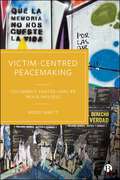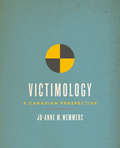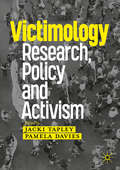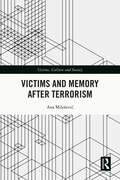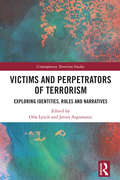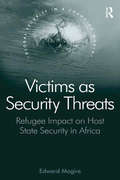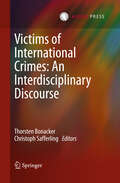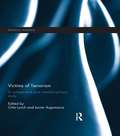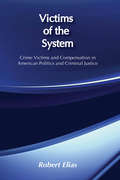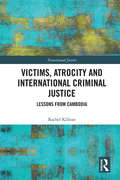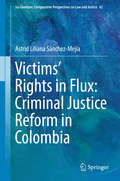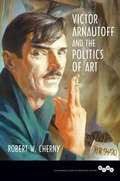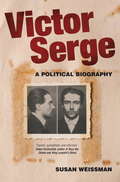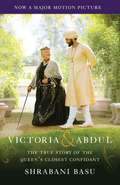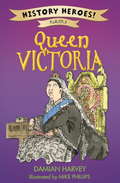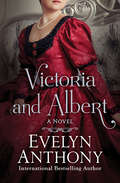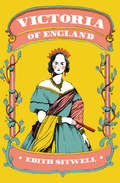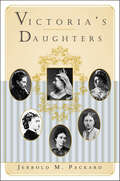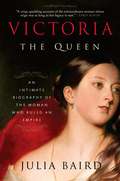- Table View
- List View
Vicky: Princess Royal of England and German Empress
by Daphne BennettFor over a hundred years the name of Victoria, Princess Royal of England, the eldest child of Queen Victoria, has lain under a shadow. It is a shadow placed over her not by accident, but quite deliberately by one man: Bismarck. Her life was already darkened by it in the middle 1860's, soon after she married the heir to the Prussian throne, for Bismarck feared and hated her almost from the moment when, in 1862, her father-in-law appointed him Minister-President of the kingdom which was within a few years to become the German Empire. It is the object of this book to dispel the shadow and to show Vicky in a truer light.
Victim 2117: Department Q 8 (Department Q)
by Jussi Adler-OlsenTHE NO. 1 INTERNATIONAL BESTSELLING AUTHOR27 MILLION BOOKS SOLDWINNER OF THE GLASS KEY AWARDIn the heart-pounding new installment of the No.1 bestselling Department Q series, a terrifying international investigation reveals the complex backstory of one of the department's own - the enigmatic Assad.The newspaper refers to the dead body only as Victim 2117 - the two thousand, one hundred and seventeenth refugee to die in the Mediterranean Sea.But to three people, the victim is so much more, and the death sets off a chain of events that throws Department Q, Copenhagen's cold cases division led by Detective Carl Mørck, into a deeply dangerous - and deeply personal - case: a case that not only reveals dark secrets about the past, but has deadly implications for the future.For a troubled Danish teen, the death of Victim 2117 becomes a symbol of everything he resents and is the perfect excuse to unleash his murderous impulses. For Ghallib, a brutal tormentor from the notorious prison Abu Ghraib, the death of Victim 2117 was the first step in a terrorist plot, years in the making. And for Department Q's Assad, Victim 2117 is a link to his buried past and to the family he assumed was long dead.'I can never get enough of Jussi Adler-Olsen' *****'The best book in the series' *****'Blew me away' *****'The master of Nordic-noir is back' *****'Brilliantly addictive' *****
Victim 2117: Department Q8: The most terrifying and personal case yet (Department Q #8)
by Jussi Adler-OlsenTHE NO. 1 INTERNATIONAL BESTSELLING AUTHOR24 MILLION BOOKS SOLDWINNER OF THE GLASS KEY AWARDIn the heart-pounding new installment of the No.1 bestselling Department Q series, a terrifying international investigation reveals the complex backstory of one of the department's own - the enigmatic Assad. The newspaper refers to the dead body only as Victim 2117 - the two thousand, one hundred and seventeenth refugee to die in the Mediterranean Sea. But to three people, the victim is so much more, and the death sets off a chain of events that throws Department Q, Copenhagen's cold cases division led by Detective Carl Mørck, into a deeply dangerous - and deeply personal - case: a case that not only reveals dark secrets about the past, but has deadly implications for the future.For a troubled Danish teen, the death of Victim 2117 becomes a symbol of everything he resents and is the perfect excuse to unleash his murderous impulses. For Ghallib, a brutal tormentor from the notorious prison Abu Ghraib, the death of Victim 2117 was the first step in a terrorist plot, years in the making. And for Department Q's Assad, Victim 2117 is a link to his buried past and to the family he assumed was long dead.'I can never get enough of Jussi Adler-Olsen' *****'The best book in the series' *****'Blew me away' *****'The master of Nordic-noir is back' *****'Brilliantly addictive' *****
Victim Participation Rights: Variation Across Criminal Justice Systems (Palgrave Studies in Victims and Victimology)
by Kerstin BraunThis book traces victims’ active participatory rights through different procedural stages in adversarial and non-adversarial justice systems, in an attempt to identify what role victims play during criminal proceedings in the domestic setting. Braun analyses countries with different legal traditions, including: the United States, England, Wales and Australia (as examples of mostly adversarial countries); Germany and France (as examples of inquisitorial systems); as well as Denmark and Sweden with their mixed inquisitorial-adversarial background. Victim Participation Rights is distinctive in that it assesses the implementation of formal processes and procedures concerning victim participation at three different procedural stages: first, investigation and pre-trial; second, trial and sentencing; and third, post-trial with a focus on appeal and parole. In addition, Braun provides an in-depth case study on the general position of victims in criminal trials, especially in light of national criminal justice policy, in Germany, a mostly inquisitorial system and Australia, a largely adversarial system. In light of its findings, the book ponders whether, at this stage in time, a greater focus on victim protection rather than on active procedural rights could be more beneficial to enhancing the overall experience of victims. In this context, it takes a close look at the merits of introducing or expanding legal representation schemes for victims.
Victim-Centred Peacemaking: Colombia’s Santos–FARC-EP Peace Process
by Roddy BrettBased on unique empirical research into Colombia’s Santos-FARC-EP peace process (2012-2016), this book interrogates how, if at all, survivors and victims may assert agency and contribute to formal peacemaking and transitional justice initiatives. The book argues that victim inclusion meaningfully transformed victim-perpetrator relations and dynamics in Havana, while partially shaping the content of both the Victims’ Agreement and Final Agreement. As such, the delegations created paths for empowerment at the individual and, in part, collective levels. However, victim inclusion also precipitated experiences of victim depoliticization, revictimization, retraumatization and instrumentalization. Drawing on insights from across academic disciplines, the book proposes an instrumentalization / empowerment spectrum to analyse the complex impact of victim-centred approaches to peacemaking/transitional justice, and is valuable for both researchers and practitioners.
Victimology: A Canadian Perspective
by Jo-Anne M. WemmersVictimology is a relatively new and emerging interdisciplinary area that crosses the fields of criminology, law, sociology, and justice. Written by one of the world’s leading experts on victimology, this book is designed to offer a broad introduction to the subject. Unlike other texts that are organized around different types of victimization, this book is informed by a victim-centred approach that treats victims’ rights as human rights.
Victimology: Research, Policy and Activism
by Pamela Davies Jacki TapleyThis book explores what victimology, as both an academic discipline and an activist movement, has achieved since its initial conception in the 1940s, from a variety of experts’ perspectives. Focussing on nine, dynamic and contemporary case studies covering topics like violence against women and girls, bereaved family activism, and environmental victims and climate change activists, each chapter critically examines how different crime victims have been politicised and explores the impact of victim-centred reforms upon criminal justice professional cultures. This book comprehensively and critically examines the historical, social and political factors, including the work of activists, that have shaped the development of theories, policies and reforms in this field, including how victimhood has come to be understood and responded to. The chapters also consider the future developments of this area, including how digital technologies are creating new forms and experiences of victimisation. Speaking to undergraduates, postgraduates and professionals in criminal justice and third sector organisations, this book discusses the links between theory, policy and professional practice and how they contribute to and facilitate debates regarding what the role of crime victims is in a 21st century criminal justice system.
Victims and Memory After Terrorism (Victims, Culture and Society)
by Ana MiloševićThis book contributes to the study of collective memory and the sociology of terrorism by analysing the role of memorialization in relation to terrorism, its victims, and the broader society. While various social scientists have extensively theorized and analysed how trauma and memory interact, grow apart, and reinforce each other, this book puts the rights and needs of the victims centre-stage.Departing from the prescriptive, legal blueprints of memory, this book introduces the concept of ‘memorial needs’ to challenge and complement existing victimological frameworks. It critically assesses the efficacy of public memorialization and its success in assisting those affected by violence by exploring how victims engage with memory and memorialization. It investigates personal and collective responses to urban terrorism in Europe that have taken a wide range of forms including media coverage, spontaneous memorials and public mobilizations, literary and artistic works, trials, and controversial counter-terrorism measures. Making a case against the fetishization of memory as an overarching answer to curing visible and invisible wounds provoked by violence, Victims and Memory After Terrorism sends out a practical invitation to the field to 'repair symbolic reparations' in a way that memorialisation is not just an expression of potential, an aspiration for a more moral and just society and a promise of healing for the victimised.An accessible and compelling read, this book will appeal to students and scholars of victimology, criminology, sociology, politics and those interested in the relationship between collective memory and terrorism.
Victims and Perpetrators of Terrorism: Exploring Identities, Roles and Narratives (Contemporary Terrorism Studies)
by Javier Argomaniz Orla LynchThis volume examines how both victims and perpetrators of terrorism are relevant to our understanding of political violence. While the perpetrators of political violence have been the subject of significant academic research, victims of terrorism and political violence have rarely featured in this landscape. In an effort to capture the vast complexity of terrorism, and to widen the scope of the agenda that informs terrorism research, this book presents a series of analyses that examines the role of the perpetrators, the experience of the victims, the public and media perceptions of both, and given the inherent intricacy of the phenomenon, how we might think about engaging with perpetrators in an effort to prevent further violence. By considering the role of the many actors who are central to our understanding and framing of terrorism and political violence, this book highlights the need to focus on how the interactivity of individuals and contexts have implications for the emergence, maintenance and termination of campaigns of political violence. The volume aims to understand not only how former perpetrators and victims can work in preventing violence in a number of contexts but, more broadly, the narratives that support and oppose violence, the construction of victimisation, the politicisation of victimhood, the justifications for violence and the potential for preventing and encouraging desistance from violence. This book will be of much interest to students of terrorism and political violence, victimology, criminology, security studies and IR in general.
Victims as Security Threats: Refugee Impact on Host State Security in Africa (Global Security in a Changing World)
by Edward MogireThe refugee phenomenon is a major force in international politics. This is more so in sub-Saharan Africa where refugees are major actors in the affairs of their home and host countries. But, are refugees just victims of insecurity or also major causes of insecurity? Mogire analyses how and why refugees, victims of insecurity caused by persecution and the many incessant conflicts which continue unabated, have come to be viewed by scholars and practitioners as security threats. Using Kenya and Tanzania as empirical case studies, this volume examines the nature of this threat, its projection and responses. Moreover, it highlights how, if at all, these threats are different or similar to other security threats faced by these countries.
Victims of International Crimes: An Interdisciplinary Discourse
by Thorsten Bonacker Christoph SafferlingIn international law victims' issues have gained more and more attention over the last decades. In particular in transitional justice processes the victim is being given high priority. It is to be seen in this context that the Rome Statute for the International Criminal Court foresees a rather excessive victim participation concept in criminal prosecution. In this volume issue is taken at first with the definition of victims, and secondly with the role of the victim as a witness and as a participant. Several chapters address this matter with a view to the International Criminal Court (ICC), the Extraordinary Chambers in the Courts of Cambodia (ECCC) and the Trial against Demjanjuk in Germany. In a third part the interests of the victims outside the criminal trial are being discussed. In the final part the role of civil society actors are being tackled. This volume thus gives an overview of the role of victims in transitional justice processes from an interdisciplinary angle, combining academic research and practical experience.
Victims of Stalking: Case Studies in Invisible Harms (Palgrave Studies in Victims and Victimology)
by Jenny KorkodeilouThis book explores the nature and impact of stalking and criminal justice system responses to this type of abuse based on the experiences and lived realities of victims. Drawing on in-depth interviews with 26 self-defined victims of stalking in England and Wales, it explores the psychological and social effects of this hidden and misunderstood form of interpersonal violence. Korkodeilou's work seeks to improve understanding regarding this type of abuse, contribute to feminist criminology and gender-based violence literature, and expand scholarly knowledge with her research's theoretical, methodological and practical implications. Victims of Stalking will appeal to academics in the fields of victimology, victimisation, gender-based and interpersonal violence, criminal justice system responses to victims and to criminal justice system professionals (e.g. police officers, probation officers, and lawyers).
Victims of Terrorism: A Comparative and Interdisciplinary Study (Political Violence)
by Javier Argomaniz Orla LynchThis book examines the politicisation of victims of terrorism and the reality of the victimisation experience within the broader field of terrorism and the resulting conflict. Victims of terrorism are a unique group of individuals whose experience is overlooked in the current literature on terrorism. Since 9/11, terrorism has risen to global prominence and has become a key topic of interest with regards to media attention and national security. As a result, many European countries (as well as the USA) have had to take active steps to protect and provide for the victims of terrorism, particularly given the nature of victimisation post-3/11 (Madrid) and 7/7 (London). Recently, we have also seen an increase in the political currency of the terrorist victim; for example, the lobbying activities and political involvement of the victims of ETA terrorism and the exceptionally powerful lobby in the USA that sees the involvement of victims of terrorism and their families in policy-making and law-enforcement transformations. This book is based on extensive field work in Northern Ireland, London and Spain and presents the results, which focus on the needs and experiences of victims of terrorism and political violence, and critically analyses these findings comparatively and in their own right. The aim is to assess the provision of support initiatives in Northern Ireland, mainland UK and Spain and understand if victims' needs are being met by these initiatives but most importantly to construct a picture of the local and international interpretation of the experience of victimisation by terrorism. This book will be of much interest to students of terrorism and political violence, victimology, criminology, security studies and IR.
Victims of the Chilean Miracle: Workers and Neoliberalism in the Pinochet Era, 1973-2002
by Peter WinnChile was the first major Latin American nation to carry out a complete neoliberal transformation. Its policies--encouraging foreign investment, privatizing public sector companies and services, lowering trade barriers, reducing the size of the state, and embracing the market as a regulator of both the economy and society--produced an economic boom that some have hailed as a "miracle" to be emulated by other Latin American countries. But how have Chile's millions of workers, whose hard labor and long hours have made the miracle possible, fared under this program? Through empirically grounded historical case studies, this volume examines the human underside of the Chilean economy over the past three decades, delineating the harsh inequities that persist in spite of growth, low inflation, and some decrease in poverty and unemployment. Implemented in the 1970s at the point of the bayonet and in the shadow of the torture chamber, the neoliberal policies of Augusto Pinochet's dictatorship reversed many of the gains in wages, benefits, and working conditions that Chile's workers had won during decades of struggle and triggered a severe economic crisis. Later refined and softened, Pinochet's neoliberal model began, finally, to promote economic growth in the mid-1980s, and it was maintained by the center-left governments that followed the restoration of democracy in 1990. Yet, despite significant increases in worker productivity, real wages stagnated, the expected restoration of labor rights faltered, and gaps in income distribution continued to widen. To shed light on this history and these ongoing problems, the contributors look at industries long part of the Chilean economy--including textiles and copper--and industries that have expanded more recently--including fishing, forestry, and agriculture. They not only show how neoliberalism has affected Chile's labor force in general but also how it has damaged the environment and imposed special burdens on women. Painting a sobering picture of the two Chiles--one increasingly rich, the other still mired in poverty--these essays suggest that the Chilean miracle may not be as miraculous as it seems. Contributors. Paul Drake Volker Frank Thomas Klubock Rachel Schurman Joel Stillerman Heidi Tinsman Peter Winn
Victims of the System: Crime Victims And Compensation In American Politics And Criminal Justice
by Robert EliasThis important new book on criminology is a major attempt to evaluate actual victim compensation programs as well as their political and economic contexts, through the eyes of the victims themselves.Elias traces the experiences of violent-crime victims throughout the entire criminal justice process, comparing New York's and New Jersey's victim compensation programs. He shows how programs differ when compensation is viewed essentially as welfare and when it is viewed as a right. The study uses extensive interviews with officials and with violent crime victims.The study indicates victim compensation programs largely fail to achieve their stated goals of improving attitudes toward the criminal-justice system and the government. The programs produce poor attitudes toward government and criminal justice.
Victims, Atrocity and International Criminal Justice: Lessons from Cambodia
by Rachel KilleanWhile international criminal courts have often been declared as bringing ‘justice’ to victims, their procedures and outcomes historically showed little reflection of the needs and interests of victims themselves. This situation has changed significantly over the last sixty years; victims are increasingly acknowledged as having various ‘rights’, while their need for justice has been deployed as a means of justifying the establishment of international criminal courts. However, it is arguable that the goals of political and legal elites continue to be given precedence, and the ability of courts to deliver ‘justice to victims’ remains contested. This book contributes to this important debate through an examination of the role of victims as civil parties within the Extraordinary Chambers in the Courts of Cambodia. Drawing on a series of interviews with civil parties, court practitioners and civil society actors, the book explores the way in which both the ECCC and the role of victims within it are shaped by specific political, economic and legal contexts; examining the ‘gap’ between the legitimising value of the ‘imagined victim’, and the extent to which victims are able to further their interests within the courtroom.
Victims’ Rights in Flux: Criminal Justice Reform in Colombia (Ius Gentium: Comparative Perspectives on Law and Justice #62)
by Astrid Liliana Sánchez-MejíaContributing to the literature on comparative criminal procedure and Latin American law, this book examines the effects of adversarial criminal justice reforms on victim’s rights by specifically analyzing the Colombian criminal justice reform of the early 2000s. This research focuses on the production, interpretation, and implementation of rules and institutions by exploring how different actors have employed the concept of victims and victims’ rights to promote their agendas in the context of criminal justice reforms. It also analyzes how the goals of these agendas have interplayed in practice. By the early 2000s, it seemed that the Colombian criminal justice system was headed towards a process characterized by broader victim participation, primarily because of the doctrine of the Constitutional Court on victims’ rights. But in 2002, the Colombian Attorney General promoted a more adversarial criminal justice reform. This book argues that this reform represented a sudden and unpredicted reversal of the Constitutional Court’s doctrine on victim participation, even though one of the central justifications for the reform was the need to satisfy human rights standards and adhere to the jurisprudence of the Constitutional Court on victims’ rights. In the criminal justice reform of the early 2000s and its subsequent modifications, the promotion of a dichotomous interpretation of the adversarial model—which conceived the criminal process as a competition between prosecution and defense—served to limit victim participation. This study examines how conceptions of victims’ rights emerged out of the struggles between different and at times competing agendas. In the Colombian process of reform, victims’ rights have been invoked both as a justification for criminal sanctions and as an explanation for crime prevention and restorative justice. After assessing quantitative and qualitative data, this book concludes that punitive approaches to victims’ rights have prevailed over restorative justice perspectives. Furthermore, it argues that punitiveness in the criminal justice system has not resulted in more protection for victims. Ultimately, this research reveals that the adversarial criminal justice reform of the early 2000s has not substantially improved the protection of victims’ rights in Colombia.
Victor Arnautoff and the Politics of Art
by Robert W. ChernyVictor Arnautoff reigned as San Francisco's leading mural painter during the New Deal era. Yet that was only part of an astonishing life journey from Tsarist officer to leftist painter. Robert W. Cherny's masterful biography of Arnautoff braids the artist's work with his increasingly leftist politics and the tenor of his times. Delving into sources on Russian émigrés and San Francisco's arts communities, Cherny traces Arnautoff's life from refugee art student and assistant to Diego Rivera to prominence in the New Deal's art projects and a faculty position at Stanford University. As Arnautoff's politics moved left, he often incorporated working people and people of color into his treatment of the American past and present. In the 1950s, however, his participation in leftist organizations and a highly critical cartoon of Richard Nixon landed him before the House Un-American Activities Committee and led to calls for his dismissal from Stanford. Arnautoff eventually departed America, a refugee of another kind, now fleeing personal loss and the disintegration of the left-labor culture that had nurtured him, before resuming his artistic career in the Soviet Union that he had fought in his youth to destroy.
Victor Serge
by Susan WeissmanRevolutionary novelist, historian, anarchist, Bolshevik and dissident--Victor Sergeis one of the most compelling figures of Soviet history. Set against some of themomentous events of the twentieth century, Victor Serge reveals dauntless vigor of a man whose views often reflect the struggles of our own time.
Victoria & Abdul (Movie Tie-In) (Movie Tie-In): The True Story of the Queen's Closest Confidant
by Shrabani BasuSoon to be a Major Motion Picture starring Dame Judi Dench from director Stephen Frears, releasing September 22, 2017.History’s most unlikely friendship—this is the astonishing story of Queen Victoria and her dearestcompanion, the young Indian Munshi Abdul Karim.In the twilight years of her reign, after the devastating deaths of hertwo great loves—Prince Albert and John Brown—Queen Victoria meets tall and handsome Abdul Karim, a humble servant from Agra waiting tables at her Golden Jubilee. The two form an unlikely bond and within a year Abdul becomes a powerful figure at court, the Queen’s teacher, her counsel on Urdu and Indian affairs, and a friend close to her heart. This marked the beginning of the most scandalous decade in Queen Victoria’s long reign. As the royal household roiled with resentment, Victoria and Abdul’s devotion grew in defiance. Drawn from secrets closely guarded for more than a century, Victoria & Abdul is an extraordinary and intimate history of the last years of the nineteenth-century English court and an unforgettable view onto the passions of an aging Queen.
Victoria (History Heroes #4)
by Damian HarveyQueen Victoria was the longest ever reigning British monarch and saw extraordinary developments during her reign, from the development of the railways to the discoveries of Charles Darwin.Discover the stories of people who have helped to shape history, ranging from early explorers such as Christopher Columbus to more modern figures like Tim Berners-Lee, inventor of the World Wide Web.These chapter books combine historical fact with engaging narrative and humourous illustration, perfect for the newly independent reader.
Victoria and Albert: A Novel
by Evelyn AnthonyDrawn from Queen Victoria's diaries and correspondences, Evelyn Anthony's novel reimagines the story of how a sheltered eighteen-year-old girl ascended to the British throne, became a major force in politics, and fell in love with her husband When King William dies, his teenage niece Victoria becomes queen. In spite of her youth and lack of experience, the eighteen-year-old surprises her detractors by taking the reins with poise and grace, vowing to always put the welfare of her realm first. Yet from the moment she meets her cousin, the handsome, fair-haired Albert, she becomes obsessed by love. Homesick for Germany, Albert wishes the petite, birdlike creature would choose someone else. But when Victoria asks him to share her life, he has no choice but to say yes. Evelyn Anthony's novel captures Victoria's passion for Albert, along with the contradictions in her personality and monstrous ego that almost destroyed her marriage. Although she bore Albert nine children, Victoria lacked maternal instinct. In many ways she mirrored the callous indifference of the era: Child labor and grueling fourteen-hour workdays were commonplace in Victorian England. Spanning the first twenty-one years of her reign, Victoria and Albert is a love story and a revealing portrait of a marriage.
Victoria of England
by Edith SitwellA lively, opinionated biography of the queen, and a vivid portrait of nineteenth-century England, from a literary icon. ‘You call me the little Queen,’ she told her uncle the King of the Belgians; ‘my body is little, but my heart is not.’ Edith Sitwell’s endearing portrait of the young Victoria chronicles her unlikely ascension to the throne: spanning the succession crisis of King George III, her enduring love and marriage to Prince Albert, and her strength and power in a male-dominated world. Weaving in Victoria’s personal letters and diaries, Sitwell breathes life into the queen’s relationships with her family and her court. A rich exploration of Victoria’s reign and a social document of Victorian Britain, Victoria of England vividly illustrates the life of the iconic monarch with insight and emotion.
Victoria's Daughters
by Jerrold M. PackardThe story of five women who shared one of the most extraordinary and privileged sisterhoods of all time.Vicky, Alice, Helena, and Beatrice were historically unique sisters, born to a sovereign who ruled over a quarter of the earth's people and who gave her name to an era: Queen Victoria. Two of these princesses would themselves produce children of immense consequence. All five would curiously come to share many of the social restrictions and familial machinations borne by nineteenth-century women of less-exulted class.Victoria and Albert's precocious firstborn child, Vicky, wed a Prussian prince in a political match her high-minded father hoped would bring about a more liberal Anglo-German order. That vision met with disaster when Vicky's son Wilhelm-- to be known as Kaiser Wilhelm-- turned against both England and his mother, keeping her out of the public eye for the rest of her life. Gentle, quiet Alice had a happier marriage, one that produced Alexandra, later to become Tsarina of Russia, and yet another Victoria, whose union with a Battenberg prince was to found the present Mountbatten clan. However, she suffered from melancholia and died at age thirty-five of what appears to have been a deliberate, grief-fueled exposure to the diphtheria germs that had carried away her youngest daughter. Middle child Helena struggled against obesity and drug addition but was to have lasting effect as Albert's literary executor. By contrast, her glittering and at times scandalous sister Louise, the most beautiful of the five siblings, escaped the claustrophobic stodginess of the European royal courts by marrying a handsome Scottish commoner, who became governor general of Canada, and eventually settled into artistic salon life as a respected sculptor. And as the baby of the royal brood of nine, rebelling only briefly to forge a short-lived marriage, Beatrice lived under the thumb of her mother as a kind of personal secretary until the queen's death.Principally researched at the houses and palaces of its five subjects in London, Scotland, Berlin, Darmstadt, and Ottawa-- and entertainingly written by an experienced biographer whose last book concerned Victoria's final days-- Victoria's Daughters closely examines a generation of royal women who were dominated by their mother, married off as much for political advantage as for love, and finally passed over entirely with the accession of their n0 brother Bertie to the throne. Packard provides valuable insights into their complex, oft-tragic lives as daughters of their time.
Victoria: An Intimate Biography of the Woman Who Ruled an Empire
by Julia BairdThis page-turning biography reveals the real woman behind the myth: a bold, glamorous, unbreakable queen--a Victoria for our times. Drawing on previously unpublished papers, this stunning new portrait is a story of love and heartbreak, of devotion and grief, of strength and resilience. "A crisp, sparkling account of the extraordinary woman whose reign was as long as her legacy is vast."--Stacy Schiff When Victoria was born, in 1819, the world was a very different place. Revolution would threaten many of Europe's monarchies in the coming decades. In Britain, a generation of royals had indulged their whims at the public's expense, and republican sentiment was growing. The Industrial Revolution was transforming the landscape, and the British Empire was commanding ever larger tracts of the globe. In a world where women were often powerless, during a century roiling with change, Victoria went on to rule the most powerful country on earth with a decisive hand. Fifth in line to the throne at the time of her birth, Victoria was an ordinary woman thrust into an extraordinary role. As a girl, she defied her mother's meddling and an adviser's bullying, forging an iron will of her own. As a teenage queen, she eagerly grasped the crown and relished the freedom it brought her. At twenty, she fell passionately in love with Prince Albert of Saxe-Coburg and Gotha, eventually giving birth to nine children. She loved sex and delighted in power. She was outspoken with her ministers, overstepping conventional boundaries and asserting her opinions. After the death of her adored Albert, she began a controversial, intimate relationship with her servant John Brown. She survived eight assassination attempts over the course of her lifetime. And as science, technology, and democracy were dramatically reshaping the world, Victoria was a symbol of steadfastness and security--queen of a quarter of the world's population at the height of the British Empire's reach. Drawing on sources that include fresh revelations about Victoria's relationship with John Brown, Julia Baird brings vividly to life the fascinating story of a woman who struggled with so many of the things we do today: balancing work and family, raising children, navigating marital strife, losing parents, combating anxiety and self-doubt, finding an identity, searching for meaning. Advance praise for Victoria: The Queen "Victoria was young enough when she assumed the throne to consult with her prime minister about her eyebrows (were they too thin?), confident enough when she married to elect to preserve the word 'obey' in her vows. Julia Baird vividly captures her in every light, at once bold and sentimental, stubborn and deferential."--Stacy Schiff "A stunning achievement . . . Neither sanitized nor mythologizing, Victoria: The Queen is a remarkably lucid, endlessly engaging account of Queen Victoria's life and rule."--Amanda Foreman "With elegance and keen insight, Julia Baird has painted a memorable, moving, and surprising portrait of one of the most important women in history. This is a remarkable book; in Baird's hands, Victoria's story resonates in our own time, shedding new light on why we live the way we do now."--Jon Meacham




